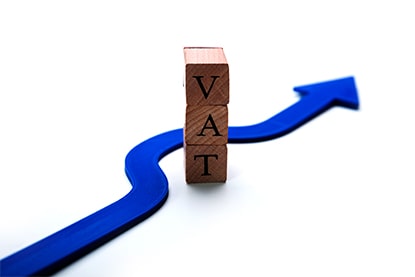GCC VAT Agreement
 Introduction
Introduction
Globally the VAT system has been around for a long time. However, for the most part, Arab countries have been operating tax-free in that respect. Over 160 countries around the world have adopted the indirect tax method to reduce the fiscal deficit and facilitate a steady increase in the country's GDP.
Following suit, an agreement between six GCC countries, namely, Bahrain, Qatar, Kuwait, Saudi Arabia, Oman, and the United Arab Emirates, had brought about a landmark change in the tax-free operations of these nations. While Saudi already had a draft VAT Law at the time of the drafting of this treaty, other GCC countries that are party to the treaty did not. However, after that, UAE and Bahrain also implemented a VAT Law in 2018 and 2019, respectively. Therefore, this treaty played a role in supplementing the development of a framework that enables countries to lay down laws regarding the implementation of the VAT system in a comprehensive manner.
The treaty is not strictly binding on the parties per se, in the sense that the countries have been provided with the option of practicing their discretion while implementing laws. Of course, there are some mandatory provisions, but there are also optional provisions to approach implementation as per their domestic and national needs.
It is important to note that this treaty is not a law; therefore, national implementation of laws in its respect is necessary for the treaty to come into force.
Background
Gulf nations heavily depend on their rich oil and energy reserves for the majority of their income. However, to survive as per global standards, diversification of the economy by utilizing other industries is becoming more and more critical. SINCE TIME IMMEMORIAL, the GCC states have been talking about improving their commercial practices and harmonizing the same with the rest of the world.
Similar to the EU, the GCC VAT Agreement also believes in a typical integrated market system. The typical market system allows a free flow of goods across nations; just like the EU, the GCC also aims to promote cross-border trade relations with their neighboring states.
Pulling inspiration from Europe, the GCC nations have made efforts to develop a common currency to strengthen their monetary union; however, those efforts were in vain due to non-acceptance by Oman and UAE.
Recent trends worldwide have required the GCC countries to pull up their socks and compete in their global market. To achieve this end, they need to diversify away from the oil and gas industry into different sectors of the economy like infrastructure, travel and tourism, VAT, etc., which is becoming a reality, slowly but surely.
Influence of Islamic Law
It is common knowledge that Shariah or Islamic law is the backbone of the legal system across the said GCC states. As per the Shariah law, there are five types of taxes, zakat playing a significant role in VAT implementation. The idea is that VAT paid to the government would allow them to provide services for the benefit of the general public. However, many GCC countries failed to institutionalize the zakat system, except Saudi Arabia. Therefore, the implementation of VAT will allow these countries to account for the funds collected.
Reasons for implementation
Dependence on oil for the majority of their revenue started to cause a deficit in the economies of GCC nations. Noticing this deficit, the International Monetary Fund (IMF) prepared a report that showed a decline in the private sector growth. Therefore, the introduction of a VAT scheme poised itself as the best solution to raise revenue. Despite VAT not being a cost-efficient exercise, global trends show that it is the most effective way of generating revenue.
The parties to the Agreement have agreed to a low rate of 5% VAT which is a good step of gradually easing into a full-fledged taxation system.
VAT benefits are not just limited to generating revenue; it facilitates consumers' discretionary spending on non-essential and harmful goods; for instance, Saudi Arabia and UAE have imposed taxes on fizzy drinks, cigarettes, etc. Further, the imposition of the Tax, even at a zero- rate, allows the government to keep in check on fraud and tax evasion, promoting economic and social growth.
Similarities between the EU and GCC VAT System
The basic principle of VAT is that its implementation differs according to the country's domestic legislation. Despite its complexities, it has been globally accepted. There are a few universally accepted principles that are implemented concerning the VAT regime, enumerated hereunder as follows;
- The VAT is levied on a wide variety of supplies and services; this means that it is levied on all levels, right from the manufacturers to the suppliers; however, an established principle of imposing VAT is the business is not the ultimate bearer of Tax, the burden shifts from the supplier to the ultimate consumer of the product.
- Further, VAT implementation is based on the destination principle; this principle lays down that, Tax is to be levied on the goods at its final destination. Therefore, exports can be transported free of Tax, whereas imports are liable to be taxed.
Legal Framework
- The EU VAT system was incorporated by the EU Council Directives, which are essentially instructions that flow into legislation. These directives do not have the force of law but are binding on the states. The nature of the directives is quite flexible, therefore, allowing the states to take liberty in applying these directives in their domestic laws.
- The EU Commission is the regulatory authority responsible for drafting treaties in the best interest of EU nations. The EU Council is an essential representative authority of the Commission. In EU law, treaties, regulations, and directives take precedence over domestic legislation. This precedence is so that the values of community loyalty and the direct effect of these treaties are upheld.
- Like the EU Directives, the GCC VAT Agreement also refers to the GCC Charter and the GCC Economic Agreement. Therefore, the Charter and Economic Agreement are the basis on which the VAT system relies. The GCC VAT Agreement is also a blanket law that governs all nations' parties to the Agreement, just like the EU.
- The GCC VAT Agreement further draws similarities with the EU VAT system since it facilitates cross-border trade activities.
Implementation
 Compared to the EU VAT system, VAT implementation in the GCC is more manageable, considering the volume of countries that would have to adopt the system and develop domestic laws to comply with the Agreement. The EU comprises 28 countries that require the implementation of the VAT Directives. On the other hand, six countries are party to the GCC VAT Agreement.
Compared to the EU VAT system, VAT implementation in the GCC is more manageable, considering the volume of countries that would have to adopt the system and develop domestic laws to comply with the Agreement. The EU comprises 28 countries that require the implementation of the VAT Directives. On the other hand, six countries are party to the GCC VAT Agreement.
Member states under both the EU and the GCC enjoy discretion about implementing the tax regime; the domestic laws may be designed as per the country's needs.
Cross border trade
Cross-border trade refers to the flow of trade from one state to another, as per the two distinct tax regimes, within the borders of the EU or the GCC nations, as the case may be. Both the EU and the GCC make a distinction between VAT charged on goods and services.
- Tax is usually charged at the place where the goods end up eventually. The final destination of the goods. There are two aspects that the EU VAT system considers when it comes to the supply of goods; first being supply and the other being acquisition. The place of departure of goods is exempted from Tax, whereas the goods are acquired where Tax is imposed. Therefore, the buyer of the goods is ultimately responsible for paying VAT. This is concerning B2B.
- In the case where goods are directly sold to the end consumer, i.e., B2C, the member state that is the supplier of goods is subject to the imposition of VAT.
- As per the reverse charge mechanism, the consumer is liable to pay VAT through their periodic return.
The GCC system is very similar to the EU in this respect as well. However, all member states have yet to incorporate the Agreement into their domestic laws. The Agreement has more of a straightforward approach in that it applies the reverse charge mechanism directly to the consumers.
Exemptions
Both the EU and GCC have a standard, reduced, and zero-rated tax regime. However, specific sectors have been exempted from being taxed under this regime with the general public's interest in mind.
The EU exempts VAT from being implemented on medical care, public postal services, welfare and security, and any other such goods or services that are essential. Moreover, the member states can practice their discretion to exempt VAT from imposing any other goods or services.
The GCC exempts VAT from being charged on health, education, and domestic transport; they can further exempt Tax from being levied on; government entities, NGOs, charitable institutions, citizens of member countries, and any other sector they deem fit.
Measures to improve the GCC VAT System
The GCC VAT Agreement draws much inspiration from the EU VAT regime. The EU regime serves as a model law that allows the GCC to adopt any such part that would serve advantageous and omit the parts that did not align with their objectives. For example, imposing a uniform tax rate of 5% throughout the GCC was an important lesson learned from the shortfalls of the EU regime.
Since parties to the GCC Agreement are relatively new to the whole idea of the tax regime, the actual use, that is, their registration, scope implications, should be clearly explained, and business owners should be educated about the topic to prevent legal complications. For example, double taxation.
The objective value of Tax that has been imposed in the GCC at the rate of 5% may pose a threat to the liberty of business owners and give rise to distortion of competition in the market. The GCC has adopted the VAT system to open its market and recover from the financial crisis. Therefore, restricting competition in the market will be detrimental to the economic objectives that the Agreement aims to achieve.
Conclusion
 The introduction of a new tax regime has its challenges. However, this is a step in the right direction to achieve economic goals such as foreign trade, competition, economic growth, and creating a global presence in the market. Further, slow and steady implementation of Tax will allow the general public to ease into the tax regime; it will also allow the government to amend the taxation as per changing trends in the economy.
The introduction of a new tax regime has its challenges. However, this is a step in the right direction to achieve economic goals such as foreign trade, competition, economic growth, and creating a global presence in the market. Further, slow and steady implementation of Tax will allow the general public to ease into the tax regime; it will also allow the government to amend the taxation as per changing trends in the economy.
The GCC nations are foreigners to the concept of Tax since they have been running tax-free since their inception. However, model tax laws implemented worldwide allow these nations to strategically examine and implement the Tax in a way that will not cause chaos in the socio-economic climate.
The effect of the Tax was seen to be an uncertain move since there was a possibility of a decrease in expenditure by the public. However, its implementation in Saudi, UAE, and Bahrain has shown that people have embraced this VAT regime, triggering a healthy social and economic response.
 English
English
 عربي
عربي Русский
Русский 官话
官话 português
português
 Türk
Türk 








.jpg&w=120&h=80&zc=1)




















